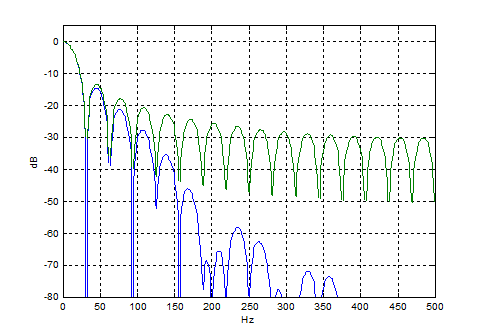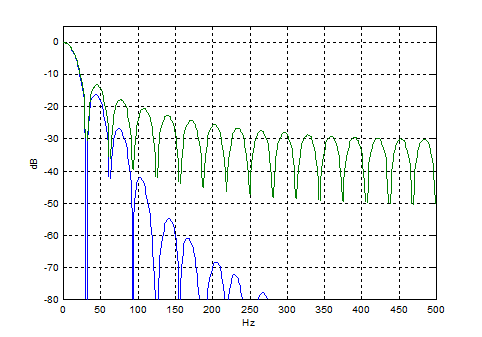Filter a Rectangular Pulse with no Ringing
To filter a rectangular pulse without any ringing, there is only one requirement on the filter coefficients: they must all be positive. However, if we want the leading and trailing edge of the pulse to be symmetrical, then the coefficients must be symmetrical. What we are describing is basically a window function.
Consider a rectangular pulse 32 samples long with fs = 1 kHz. Here is the Matlab code to generate the pulse:
N= 64; fs= 1000; % Hz sample frequency n= 0:N-1; % time index t= n/fs*1000; % ms % 1. pulse x= [0 0 0 0 ones(1,32) zeros(1,28)]; plot(t,x),grid
Let’s filter the pulse using a Hanning window. Note this is not the typical way window functions are used: here, the window is shorter than the signal vector and we are convolving the window with the signal (not performing an element-by-element multiplication). Also, we divide the window coefficients by their sum to make the dc component = 1.
b= hanning(9)/5; % N = 9 Hanning window stem(b),grid,figure y= filter(b,1,x); % filter the pulse x plot(t,y,'o-'),grid
The Pulse is shown in Figure 1, the Hanning Window in Figure 2, and the filtered pulse is shown in Figure 3. The edges of the pulse now have duration equal to the length of the window. If we use an N= 15 Hanning window, we get slower edges, as shown in Figure 4.
We can compute the spectra of the original pulse and the filtered pulse as follows:
[h,f]= freqz(x/32,1,512,fs); % spectrum of unfiltered pulse H= 20*log10(abs(h)); [h,f]= freqz(y/32,1,512,fs); % spectrum of filtered pulse H_filt= 20*log10(abs(h)); plot(f,H_filt,f,H),grid
The pulse spectra for the N= 9 and N= 15 Hanning window cases are shown in Figures 5 and 6. You can see that the pulse with the faster edges has a wider spectrum.
Finally, we note that these filters are not meant for channel filtering of signals like QAM. QAM systems typically use square-root Nyquist filters (also called Root Raised Cosine filters), which produce spectrally-efficient pulses with precise spacing of the time-response nulls, in order to minimize inter-symbol interference.

Figure 1. Pulse with duration of 32 samples, fs = 1 kHz.

Figure 2. N = 9 Hanning window hanning(9)/5

Figure 3. Pulse filtered by N = 9 Hanning window.

Figure 4. . Pulse filtered by N = 15 Hanning window.

Figure 5. Pulse Spectra. Blue = Pulse filtered by N = 9 Hanning window
Green = Unfiltered pulse

Figure 6. Blue = Pulse filtered by N= 15 Hanning window.
Green = Unfiltered Pulse
m-file
% pulse_filter1.m 5/12/16 nr
% Filter a rectangular pulse with a hanning window
N= 64;
fs= 1000; % Hz sample frequency
n= 0:N-1; % time index
t= n/fs*1000; % ms
% 1. pulse
x= [0 0 0 0 ones(1,32) zeros(1,28)];
plot(t,x),grid
axis([0 N -.2 1.2]),xlabel('ms'),figure
% 2. filter pulse x with a window function
% edge of filtered pulse has duration = window length
b= hanning(9)/5; % hanning window
%b= hanning(15)/8;
stem(b),grid,figure
y= filter(b,1,x); % filter the pulse x
plot(t,y,'o-'),grid
axis([0 N -.2 1.2]),xlabel('ms'),figure
% 3. Pulse spectra
[h,f]= freqz(x/32,1,512,fs); % spectrum of unfiltered pulse
H= 20*log10(abs(h));
[h,f]= freqz(y/32,1,512,fs); % spectrum of filtered pulse
H_filt= 20*log10(abs(h));
plot(f,H_filt,f,H),grid
axis([0 fs/2 -80 5]),xlabel('Hz'),ylabel('dB')
5/12/16
- Comments
- Write a Comment Select to add a comment



The advantage of a filter (convolution) is that the pulse can be of any length, or there can be multiple pulses. Filtering will smooth every edge.


I beg to differ! Change 2 lines in the m-file as follows:
original code:
N = 64;
x= [0 0 0 0 ones(1,32) zeros(1,28)];
new code:
N= 128;
x= [0 0 0 0 ones(1,32) zeros(1,28) ones(1,32) zeros(1,32)];
You will find the filtering works great.
regards,
Neil


x = zeros(1,100);
x(4:4:end) = 1;
x(5:4:end) = 1;
h=hanning(9)
y=filter(h,1,x);
plot(y)

OK. I see your problem. For the window to work as a LPF, the pulse should be twice as long as the length of the window, or longer.
Note your pulse train cannot easily be filtered because there are only 2 samples during the pulse duration. In my example, there are 32 samples in the pulse duration.

I need to correct myself. Actually, the pulse can be equal to the length of the window or longer (not twice the length of the window).
regards, neil
To post reply to a comment, click on the 'reply' button attached to each comment. To post a new comment (not a reply to a comment) check out the 'Write a Comment' tab at the top of the comments.
Please login (on the right) if you already have an account on this platform.
Otherwise, please use this form to register (free) an join one of the largest online community for Electrical/Embedded/DSP/FPGA/ML engineers:


















